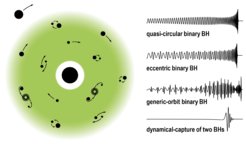Making sense of the unexpected in the gravitational-wave sky
The Max Planck Institute for Gravitational Physics is one of the four partners in the international consortium GWSky, which the European Research Council has awarded 12 million euros to develop a deeper understanding of gravitational waves.
Existing and future gravitational-wave detectors will be capable of observing signals with such precision that they may reveal possible deviations from Einstein's general theory of relativity and the standard model of particle physics. To fully exploit this unique instrumental capability, fundamental advances are required in the theoretical description of black holes and their dynamics, the gravitational waves they emit, their cosmic environment, and the physics beyond the standard model. To provide the necessary theoretical framework, the project GWSky has been awarded 12 million euros over the next six years by the European Research Council. The ERC Synergy grant involves four nodes: the Max Planck Institute for Gravitational Physics (Albert Einstein Institute, AEI) at the Potsdam Science Park, the Niels Bohr Institute in Copenhagen, the SISSA (Scuola Internazionale Superiore di Studi Avanzati) in Trieste, and the University of California, in Los Angeles.
The aim of the project called “Making Sense of the Unexpected in the Gravitational-Wave Sky” (GWSky), is to use gravitational-wave measurements by existing and future observatories on the Earth and in space as precision laboratories for fundamental physics, cosmology, and astrophysics. This includes the current LIGO-Virgo-KAGRA detectors, as well as the future ground-based observatories Cosmic Explorer and Einstein Telescope, and the space-based detector LISA.
Future observations will enable us to detect hundreds of times weaker signals than those currently measurable, inevitably leading to the discovery of anomalies and deviations from current predictions. “Even tiny deviations from general relativity would have a profound impact on our understanding of physics, but to claim such a deviation, it is first necessary to filter out the contributions from the astrophysical environment, instrumental artifacts, and systematic modeling uncertainties,” says Alessandra Buonanno, director at the AEI in Potsdam Science Park, and one of the four principal investigators of the project.

To realize the full potential of future observations, the GWSky project will build on recent advances and the world-leading expertise of its principal investigators and their teams. Using this know-how in astrophysics, source modeling, particle physics, and general relativity, the researchers aim to develop a groundbreaking framework. With it they will solve Einstein’s complex equations, predict gravitational waves with unprecedented accuracy, and translate these results into practical tools for interpreting the data.
Remarkably, the AEI in Potsdam Science Park was awarded two ERC Synergy Grants (GWSky and MaScAmp) this year. Overall, researchers at the Max Planck Institute for Gravitational Physics in Potsdam have received six ERC Grants in different funding lines.
“The GWSky project will have a significant impact on gravitational-wave science. It will enable us to infer the properties of gravitational-wave sources with precision limited only by measurement uncertainties, potentially revealing new and unexpected phenomena in our Universe,” concludes Buonanno.
ERC Synergy Grants
The European Research Council awards Synergy Grants for scientifically excellent research projects through a complex and competitive selection process. Grants are awarded for a period of six years and are generally worth up to 10 million euros. Additional funding can be requested for large-scale equipment relevant to the project. The funding is available for projects involving two to four principal investigators. In the current selection round, the ERC will fund 57 projects out of 548 research proposals submitted from all scientific disciplines. This corresponds to a success rate of 10.4 percent.
The GWSky project will receive a total of 11.98 million euros, of which 3.27 million euros will go to the “Astrophysical and Cosmological Relativity” department at the Max Planck Institute for Gravitational Physics in Potsdam Science Park.
Besides Alessandra Buonanno, the other principal investigators of this ERC Synergy Grant are:
- Enrico Barausse, SISSA (Scuola Internazionale Superiore di Studi Avanzati), Trieste, Italy
- Zvi Bern, University of California, Los Angeles, USA
- Maarten van de Meent, Niels Bohr Institute, Copenhagen, Denmark












